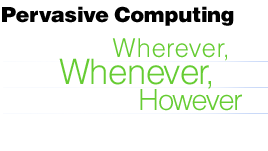 |
 |
|
||||
Is Computing and Pervasive Computing the same thing????
NO!!
Pervasive means "diffused throughout every part of." Ubiquitous computing would be everywhere, and pervasive computing would be in all parts of your life.
And, in fact, that's where the difference between these two types of computing lies. Pervasive computing involves devices like hand-helds --small, easy-to-use devices -- through which we'll be able to get information on anything and everything. That's the sort of thing that Web-enabled cell phones promise. Ubiquitous computing, though, eschews our having to use computers at all. Instead, it's computing in the background, with technology embedded in the things we already use. That might be a car navigation system that, by accessing satellite pictures, alerts us to a traffic jam ahead, or an oven that shuts off when our food is cooked. **this was taken from the following article:
| Title: | Ubiquitous? Pervasive? Sorry, they don't compute. |
| Source: | Computerworld, 03/20/2000, Vol. 34 Issue 12, p44, 1/2p |
| Author(s): | McCrory, Anne; Judge, Jargon |
| Abstract: | Explains ubiquitous computing and pervasive computing. Differences between the two types of computing; Comments from ubiquitous computing inventor, Mark Weiser. |
The National Institute of Standards and Technology, Gaithersburg, Md., puts an ongoing effort into assisting private industry. The field of pervasive computing is still in its infancy, and many of the technologies needed to make it a reality are immature and involve high risk. NIST's role is to develop unbiased tests and standards that will help push the underlying technologies forward and help the pervasive computing field mature and grow.
To reach that point, the availability of essential reference data and measurement capabilities must be ensured. NIST's Information Technology Laboratory (ITL) plans to develop metrics, test methods, and standards that will aid the development and integration of emerging and existing technologies. The technologies initially being explored by NIST include advanced forms of human-computer interaction and information access, integration of pico-cellular wireless with dynamic service discovery and automatic device configuration, and software infrastructures for programming pervasive computing applications. **This was taken from the following article:
| Title: | Pervasive computing/smart spaces pose a host of challenges. |
| Source: | Electronic Design, 03/06/2000, Vol. 48 Issue 5, p52, 2/3p |
| Author(s): | Herman, Martin |
| Abstract: | Discusses potential challenges that may be encountered by consumers in the computer industry. Major trends that have occurred within the computing arena; Prediction that computers will have capabilities to sense their environment and react intelligently in the future; Need to ensure the availability of essential reference data and measurement capabilities to promote growth in the pervasive computing sector. |
The problem becomes more severe as we begin to use large numbers of devices that need access to the same data. Handheld organizers are great for storing phone lists, and many phones also can store phone lists--but today they can't share. To fully exploit the new world of pervasive computing, our information must become device-independent. A phone list, for example, should be stored on the Web, and every telephone, organizer or PC should synchronize with that central source. As another example, your list of bookmarked Web sites should be available to you from any Web browser, not just the one on your primary machine.
One barrier to this new environment is the lack of pervasive, always-on, high-bandwidth network connections. That problem is going to be solved; it will take longer than most people would like, and it requires a massive investment, but that investment is being made. The more fundamental barrier is the need for widely used, vendor-independent, standard formats for all shared data. Because such standardization is contrary to the interests of the market leaders in any given category, it will be resisted by the very companies that have the greatest power to create it. Only when users insist on it will such standardization begin to occur in a meaningful way. **This was taken from the following article:
| Title: | Changing the storage paradigm. |
| Source: | Electronic Business, May2000, Vol. 26 Issue 5, p14, 1p |
| Author(s): | Slater, Michael |
| Abstract: | Comments on shifting the paradigm of data storage. Problem with personal disk paradigm; Contribution of Network Computer concept to computing; Pieces of advice on how to exploit the world of pervasive computing. |